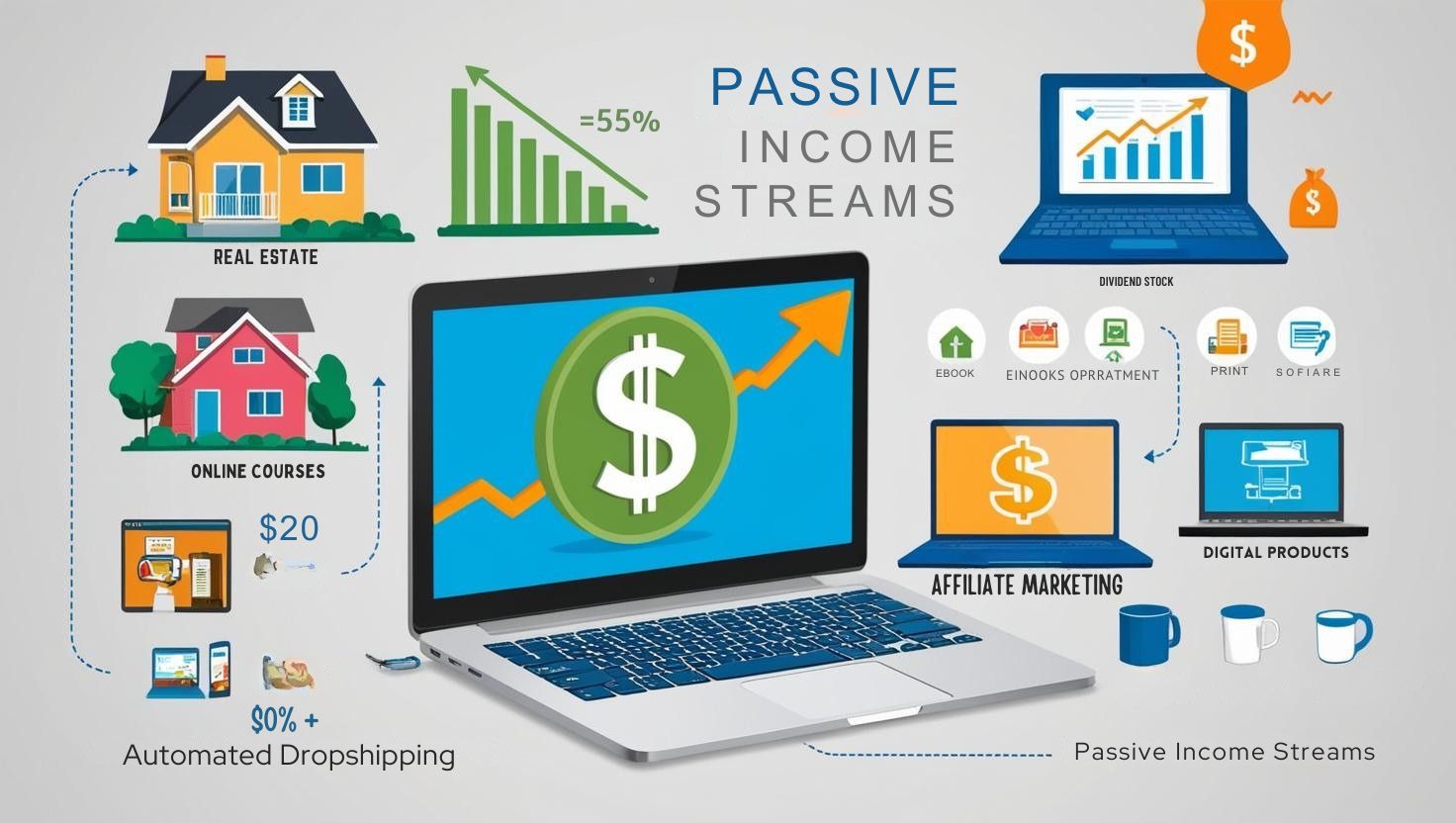Passive income is the key to financial freedom, allowing you to earn money with minimal effort over time. Whether you want to supplement your 9-to-5 job or achieve complete financial independence, the right passive income strategy can make it possible. In this guide, we’ll explore 7 passive income ideas you can start today, from investing in dividend stocks to selling digital products. These methods require an initial effort but can generate long-term, hands-free income.
Table of Contents
1. Dividend Stocks
Dividend stocks are one of the most reliable ways to generate passive income. By investing in companies that pay regular dividends, you can earn a steady stream of income without selling your shares. Many large corporations, such as Coca-Cola, Johnson & Johnson, and Procter & Gamble, have a long history of paying dividends, making them attractive for long-term investors.
How to Start Investing in Dividend Stocks
- Choose a Brokerage Account – Open an account with a reputable brokerage like Robinhood, Fidelity, or Vanguard.
- Research Dividend-Paying Stocks – Look for companies with a history of consistent and growing dividends.
- Check the Dividend Yield – A good dividend yield is usually between 2% and 6%, but higher yields may indicate financial instability.
- Diversify Your Portfolio – Invest in different industries to reduce risk.
- Reinvest Dividends – Use a Dividend Reinvestment Plan (DRIP) to buy more shares and compound your earnings.
2. Real Estate Rentals
Tips for Generating Passive Income from Rentals
Real estate rentals have long been one of the most popular and reliable ways to generate passive income. By renting out properties, you can earn consistent cash flow with relatively low ongoing effort—once the initial setup is complete. However, success in real estate rentals requires careful planning, smart investments, and effective management. Here are some actionable tips to help you generate passive income from rental properties:
1. Choose the Right Location
Location is everything in real estate. Look for areas with strong rental demand, such as neighborhoods near schools, business hubs, or public transportation. Research local market trends, vacancy rates, and potential for property value appreciation. A good location ensures steady tenants and higher rental income.
2. Start Small and Scale Gradually
If you’re new to real estate, consider starting with a single-family home or a duplex. These properties are easier to manage and require less upfront capital compared to large apartment complexes. As you gain experience and build equity, you can expand your portfolio.
3. Hire a Property Management Company
To truly make your rental income passive, consider hiring a property management company. They handle tenant screening, rent collection, maintenance, and other day-to-day tasks. While this comes at a cost (typically 8-12% of the monthly rent), it frees up your time and reduces stress.
4. Set Competitive Rental Prices
Pricing your rental property correctly is crucial. Charge too much, and you risk long vacancies; charge too little, and you leave money on the table. Research comparable properties in the area and set a competitive price that attracts tenants while maximizing your income.
5. Invest in Low-Maintenance Properties
Choose properties that require minimal upkeep to reduce maintenance costs and headaches. Newer homes or recently renovated properties often have fewer issues. Additionally, consider durable materials and finishes that can withstand wear and tear from tenants.
6. Leverage Technology
Use technology to streamline your rental business. Online platforms like Zillow or Apartments.com can help you list your property and find tenants quickly. Tools like TurboTenant or RentRedi can simplify rent collection, lease agreements, and communication with tenants.
7. Screen Tenants Thoroughly
A bad tenant can turn your passive income stream into a nightmare. Conduct thorough background checks, verify employment and income, and contact previous landlords to ensure you’re renting to reliable individuals. A good tenant pays rent on time and takes care of your property.
8. Consider Short-Term Rentals
If you’re in a tourist-friendly area, consider listing your property on platforms like Airbnb or Vrbo. Short-term rentals often generate higher income than long-term leases, though they require more active management. Hiring a co-host or using automation tools can help make this more passive.
9. Reinvest Your Profits
Reinvesting your rental income into property upgrades, additional real estate, or paying down your mortgage can help you grow your portfolio and increase your passive income over time.
10. Stay Compliant with Local Laws
Real estate rentals come with legal responsibilities. Familiarize yourself with local landlord-tenant laws, zoning regulations, and tax requirements. Staying compliant protects you from potential lawsuits and financial penalties.
By following these tips, you can turn real estate rentals into a sustainable source of passive income. While it requires upfront effort and investment, the long-term rewards can be substantial, providing you with financial stability and freedom.
3. Create an Online Course
Creating an online course is a great way to generate passive income by sharing your knowledge or skills. Once the course is created, you can sell it repeatedly with minimal effort.
Best Platforms to Sell Your Online Course:
- Udemy: Ideal for beginners, it has a large audience, and you don’t need to worry about marketing.
- Teachable: Offers more control over your branding and pricing. Great for building a personal course brand.
- Skillshare: Focuses on creative fields and is membership-based, meaning you earn revenue based on how many people watch your classes.
- Thinkific: A versatile platform with customization options for creating a professional-looking course.
Choose a platform that aligns with your course content and goals to start generating passive income.
4. Affiliate Marketing
Affiliate marketing allows you to earn passive income by promoting products or services and earning a commission for each sale made through your referral.
How to Get Started with Affiliate Marketing:
- Choose a Niche: Pick a topic you’re passionate about or knowledgeable in, whether it’s tech, fitness, or beauty.
- Find Affiliate Programs: Join networks like Amazon Associates, ShareASale, or Commission Junction to find products to promote.
- Create Content: Build a website, blog, or social media presence where you can share product reviews, tutorials, or recommendations.
- Drive Traffic: Use SEO, paid ads, or social media to increase visitors to your content, boosting your affiliate sales.
- Track Results: Use analytics tools to measure your performance and optimize your strategies for higher earnings.
Once set up, affiliate marketing can generate consistent passive income with minimal ongoing work.
5. Sell Digital Products
Selling digital products is a fantastic way to earn passive income. Once created, they can be sold repeatedly without the need for inventory or shipping.
Profitable Digital Products You Can Sell:
- E-books: Share your expertise on a specific topic in a digital book format.
- Printables: Create templates, planners, or art prints that customers can download and print.
- Stock Photos or Graphics: If you’re a photographer or graphic designer, selling your digital artwork can be lucrative.
- Software or Apps: If you have coding skills, creating and selling software or mobile apps can bring in passive income.
- Online Guides or Toolkits: Offer step-by-step guides or downloadable toolkits that help solve specific problems.
Platforms like Etsy, Gumroad, or your own website can be used to sell these digital products and generate ongoing revenue.
6. Print on Demand Business
A print on demand (POD) business allows you to sell custom-designed products without holding inventory. Your designs are printed on items like t-shirts, mugs, or posters as customers place orders.
Steps to Launch a Print on Demand Store:
- Choose a Niche: Focus on a specific audience or theme to create unique designs that resonate with buyers.
- Create Designs: Use tools like Canva or Adobe Illustrator to create eye-catching graphics or slogans.
- Select a POD Platform: Popular platforms include Printful, Teespring, and Printify, which handle printing and shipping for you.
- Set Up an Online Store: Use platforms like Shopify, Etsy, or WooCommerce to create your store and integrate with your POD service.
- Market Your Products: Promote your store through social media, ads, or influencers to drive traffic and sales.
Once launched, you can earn passive income as your products sell automatically without the need for manual intervention.
7. Automated Dropshipping
Dropshipping allows you to sell products without managing inventory, but to make it truly passive, automation is key.
How to Make Dropshipping Passive:
- Choose a Profitable Niche: Focus on a niche with steady demand and low competition to simplify marketing.
- Find Reliable Suppliers: Use platforms like Oberlo or Spocket to find suppliers who offer automated fulfillment.
- Set Up an E-commerce Store: Create a store on Shopify or WooCommerce, and integrate with your chosen dropshipping platform.
- Automate Order Fulfillment: Set up automatic order processing and shipment tracking so you don’t have to manage orders manually.
- Use Marketing Automation: Implement automated email campaigns, social media posts, and ads to keep attracting customers without ongoing effort.
- Optimize for SEO: Build a website with strong SEO so you can attract organic traffic, reducing the need for constant ad spend.
With the right tools, automated dropshipping can run almost entirely on autopilot, providing you with a consistent stream of passive income.
Final Thoughts
Achieving financial freedom through passive income takes time, effort, and strategic planning, but once set up, it can provide long-term stability and independence. Whether you invest in dividend stocks, create online courses, or dive into dropshipping, each method offers unique benefits with the potential to generate revenue while you focus on other pursuits.
Key Takeaways for Financial Freedom
- Start small: Begin with one passive income stream and scale up as you gain experience.
- Diversify: Combining multiple income sources can provide more financial security and reduce risks.
- Consistency is key: Success in passive income often requires patience and continual optimization.
- Leverage technology: Use automation tools to minimize active involvement and maximize earnings.
- Educate yourself: The more you learn, the better equipped you’ll be to navigate different passive income opportunities.
By taking the steps to build and maintain passive income streams, you’re on the path to achieving financial freedom and gaining more control over your financial future.
FAQ
1. What is passive income?
Passive income is money earned with little to no ongoing effort after the initial setup. This can come from investments, businesses, or creative work that continues to generate revenue over time.
2. How much money do I need to start earning passive income?
The amount depends on the method you choose. Some options, like affiliate marketing or selling digital products, require minimal upfront investment. Others, like real estate rentals or dividend stocks, might need more capital to start.
3. Can I make passive income without quitting my job?
Yes! Many people start with a side hustle or invest in passive income streams while still working full-time. Over time, these streams can grow and potentially replace your main income.
4. How long does it take to start earning passive income?
Building a steady passive income stream takes time. Some methods, like dividend stocks, can take months or years to see significant returns. Others, like creating an online course or selling digital products, can start generating income relatively quickly once your product is ready.
5. Is passive income truly “passive”?
While these income sources require minimal effort once set up, they often require ongoing maintenance, such as marketing, updates, or monitoring. However, the goal is to create systems that generate money with little involvement.








